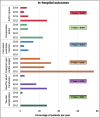Transcatheter aortic valve replacement in patients with bicuspid aortic valve stenosis: national trends and in-hospital outcomes
- PMID: 32110546
- PMCID: PMC7014993
- DOI: 10.4103/ajm.ajm_134_19
Transcatheter aortic valve replacement in patients with bicuspid aortic valve stenosis: national trends and in-hospital outcomes
Abstract
Background: Bicuspid aortic valve (BAV) disease is considered the most common congenital heart disease and the main etiology of aortic valve stenosis (AS) in young adults. Although transcatheter aortic valve replacement (TAVR) is routinely used in high- and intermediate-risk patients with AS, BAV patients with AS were excluded from all pivotal trials that led to TAVR approval. We sought, therefore, to examine in-hospital outcomes of patients with BAV who underwent TAVR in comparison with surgical aortic valve replacement (SAVR).
Methods: Using the National Inpatient Sample from 2011 to 2014, we identified patients with BAV with International Classification of Diseases-Ninth Revision-CM code 746.4. Patients who underwent TAVR were identified using ICD-9 codes 35.05 and 35.06 and those who underwent SAVR were identified using codes 35.21 and 35.22 during the same period.
Results: A total of 37,052 patients were found to have BAV stenosis. Among them, 36,629 patients (98.8%) underwent SAVR, whereas 423 patients (1.14%) underwent TAVR. One-third of enrolled patients were female, and the majority of the patients were White with a mean age of 65.9 ± 15.1 years. TAVR use for BAV stenosis significantly increased from 0.39% in 2011 to 4.16% in 2014 (P < 0.001), which represents a 3.77% overall growth in procedure rate. The median length of stay decreased significantly throughout the study period (mean 12.2 ± 8.2 days to 7.1 ± 5.9 days, P < 0.001). There was no statistically significant difference between SAVR and TAVR groups in the in-hospital mortality (0% vs. 5.9%; adjusted P = 0.119).
Conclusion: There is a steady increase in TAVR use for BAV stenosis patients along with a significant decrease in length of stay.
Keywords: Bicuspid aortic valve stenosis; surgical aortic valve replacement; transcatheter aortic valve replacement.
Copyright: © 2020 Avicenna Journal of Medicine.
Conflict of interest statement
There are no conflicts of interest.
Figures




Similar articles
-
Transcatheter and surgical aortic valve replacement in patients with bicuspid aortic valve.Clin Res Cardiol. 2021 Mar;110(3):429-439. doi: 10.1007/s00392-020-01761-3. Epub 2020 Oct 24. Clin Res Cardiol. 2021. PMID: 33099681 Free PMC article.
-
Transcatheter and Surgical Aortic Valve Replacement in Patients With Bicuspid Aortic Valve Stenosis.Ann Thorac Surg. 2023 Mar;115(3):611-618. doi: 10.1016/j.athoracsur.2022.06.030. Epub 2022 Jul 13. Ann Thorac Surg. 2023. PMID: 35841951
-
Temporal Trends and Outcomes of Transcatheter Versus Surgical Aortic Valve Replacement for Bicuspid Aortic Valve Stenosis.JACC Cardiovasc Interv. 2019 Sep 23;12(18):1811-1822. doi: 10.1016/j.jcin.2019.06.037. JACC Cardiovasc Interv. 2019. PMID: 31537280
-
Transcatheter aortic valve replacement for bicuspid aortic valve disease: does conventional surgery have a future?Ann Cardiothorac Surg. 2022 Jul;11(4):389-401. doi: 10.21037/acs-2022-bav-20. Ann Cardiothorac Surg. 2022. PMID: 35958538 Free PMC article. Review.
-
Transcatheter Aortic Valve Replacement in Bicuspid Aortic Valve Stenosis.Circulation. 2021 Mar 9;143(10):1043-1061. doi: 10.1161/CIRCULATIONAHA.120.048048. Epub 2021 Mar 8. Circulation. 2021. PMID: 33683945 Review.
Cited by
-
Feasibility and safety of next-day discharge following transcatheter bicuspid aortic valve replacement.Int J Cardiol Heart Vasc. 2022 Aug 2;42:101101. doi: 10.1016/j.ijcha.2022.101101. eCollection 2022 Oct. Int J Cardiol Heart Vasc. 2022. PMID: 35937949 Free PMC article.
-
US Mortality Attributable to Congenital Heart Disease Across the Lifespan From 1999 Through 2017 Exposes Persistent Racial/Ethnic Disparities.Circulation. 2020 Sep 22;142(12):1132-1147. doi: 10.1161/CIRCULATIONAHA.120.046822. Epub 2020 Aug 3. Circulation. 2020. PMID: 32795094 Free PMC article.
-
Transcatheter Aortic Valve Replacement Versus Surgical Aortic Valve Replacement in Bicuspid Aortic Valve Stenosis-We Need a Well-Designed Randomized Control Trial.J Clin Med. 2024 Oct 31;13(21):6565. doi: 10.3390/jcm13216565. J Clin Med. 2024. PMID: 39518704 Free PMC article. Review.
-
A Meta-Analysis of Short-Term Outcomes of TAVR versus SAVR in Bicuspid Aortic Valve Stenosis and TAVR Results in Different Bicuspid Valve Anatomies.J Clin Med. 2023 Nov 28;12(23):7371. doi: 10.3390/jcm12237371. J Clin Med. 2023. PMID: 38068423 Free PMC article. Review.
References
-
- Leon MB, Smith CR, Mack M, Miller DC, Moses JW, Svensson LG, et al. Transcatheter aortic-valve implantation for aortic stenosis in patients who cannot undergo surgery. N Engl J Med. 2010;363:1597–607. - PubMed
-
- Smith CR, Leon MB, Mack MJ, Miller DC, Moses JW, Svensson LG, et al. Transcatheter versus surgical aortic-valve replacement in high-risk patients. N Engl J Med. 2011;364:2187–98. - PubMed
-
- Reardon MJ, Van Mieghem NM, Popma JJ, Kleiman NS, Søndergaard L, Mumtaz M, et al. Surgical or transcatheter aortic-valve replacement in intermediate-risk patients. N Engl J Med. 2017;376:1321–31. - PubMed
-
- Leon MB, Smith CR, Mack MJ, Makkar RR, Svensson LG, Kodali SK, et al. Transcatheter or surgical aortic-valve replacement in intermediate-risk patients. N Engl J Med. 2016;374:1609–20. - PubMed
LinkOut - more resources
Full Text Sources
Research Materials

